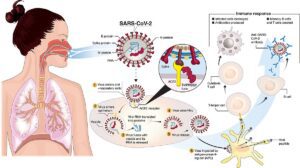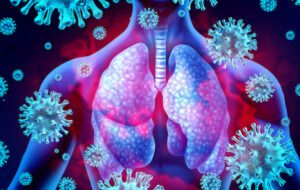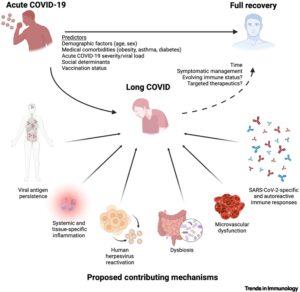
The SAR-CoV-2 virus traveled throughout the body, including the brain, and lasted for almost 8 months, according to a review of autopsied tissue samples from 44 people who died of COVID-19.
The SAR-CoV-2 virus traveled throughout the body, including into the brain, and persisted for almost 8 months, according to an examination of tissue samples from the autopsies of 44 persons who died from COVID-19. On December 14th, the study appeared in the magazine Nature.
Researchers from the National Institutes of Health (NIH) examined autopsy samples collected between April 2020 and March 2021. They carefully sampled the entire nervous system, including the brain, in 11 of the patients.
SAR-CoV-2, RNA, and live viruses in different organs
38 patients’ blood plasma tested positive for SARS-CoV-2, 3 patients’ blood plasma tested negative, and 3 patients’ blood plasma was not available. None of the patients had received any vaccinations, and they all died from COVID-19.
30% of the patients were female, with a median age of 62.5 years. Of the patients, 27, or 61.4%, had three or more comorbidities. A median of 18.5 days passed between the beginning of symptoms and death.
According to analysis, SARS-CoV-2 mostly infected and negatively affected lung and airway tissue. However, 84 more anatomical components and body fluids were also shown to have viral RNA by the researchers. In one case, scientists took viral RNA 230 days after the patient first experienced symptoms.
The researchers discovered SARS-CoV-2 RNA and protein in the hypothalamus and cerebellum of one patient, the spinal cord, and the basal ganglia of two additional patients. However, scientists found that “despite considerable viral burden,” there was no damage to brain tissue.
The adrenal gland, eye, brain, heart, lymph nodes, digestive tract, and lymph nodes are just a few of the sites inside and outside the respiratory system where the researchers discovered live SARS-CoV-2 virus. 25 (or 45%) of the 55 examined specimens had viral isolation.
In multiple non-respiratory areas, the authors asserted, “We demonstrated virus replication over the first two weeks after symptom start.”
We were able to extract the SARS-CoV-2 virus in cell culture from a variety of non-respiratory organs, including the brain, which is characterized differently, and detect and quantify SARS-CoV-2 RNA levels with high sensitivity using [polymerase chain reaction] and [in situ hybridization]. The brain was dissected before fixation, tissue was preserved in RNA later, and fresh tissue was flash-frozen. We also concentrated on short postmortem intervals, a thorough, standard tissue collection procedure, and brain dissection before fixation.
SAR-CoV-2, Consequences that could result from “long COVID”
According to an NIH news release by senior study author Daniel Chertow, MD, MPH, “the understanding in the field was that SARS-CoV-2 was largely a respiratory virus before the work.”
Researchers were able to investigate a connection between broadly infected bodily tissues and “long COVID,” or symptoms that last for weeks or months after infection, thanks to the discovery of viral presence throughout the body and the sharing of those data with colleagues a year ago.
“We’re hoping to replicate the data on viral persistence and study the relationship with long COVID.”
— Study coauthor Stephen Hewitt, MD, PhD
A Paxlovid RECOVER study that is expected to begin in 2023 will include an expansion of the autopsy work detailed in the Nature research, according to coauthor Stephen Hewitt, MD, Ph.D., who also serves on a steering board for the RECOVER project. The autopsies in the RECOVER trial include people who were both immunized and infected with variants of concern—information that wasn’t available in the prior study.
According to Hewitt, we want to corroborate the evidence on viral persistence and look into the relationship with extended COVID. “In less than a year, we have about 85 cases, and we are aiming to expand these programs.”
SAR-CoV-2 remains in the body for how long?
There is no conclusive response. It is difficult to determine how long a person would have continued to shed the virus if they had survived because the fact of 6.2 million deaths from covid-19 implies that many people pass away from the virus’ internal consequences before the virus itself does.
Additionally, depending on underlying medical issues, some people recover from viruses more quickly than others. Paul Hunter, a professor of medicine at the University of East Anglia, cites one example: “Even before COVID, we knew that persons with particular immunological deficits can struggle to remove infections.”
SAR-CoV-2, What have the Covid-19 infections’ longest recorded episodes been?
According to a case presented at the European Congress of Clinical Microbiology and Infectious Diseases in April 2022, one patient tested positive for covid-19 for 505 days before passing away.
1 According to another study by Spanish researchers, a 52-year-old man receiving chemotherapy was still shedding the virus 189 days later.
2 Chinese researchers identified a 64-year-old man who shed the virus for 169 days following infection in another study. 3
All of that was captured through the mouth and nose, which is typical for a respiratory virus. The location and duration of SARS-appearance CoV-2’s elsewhere in the body, however, are rare.
According to the research, the virus was still detectable in a patient’s feces seven months after diagnosis, proving that it persists in the body longer than previously believed. It poses a problem for scientists who are currently looking into possible connections between long covid and SARS-CoV-2 in the gut.
The average person continued to shed the virus for around a month, according to a meta-analysis6 looking at how long SARS-CoV-2 infected people continue to do so. However, some people are extreme virus shedders who continuously release viruses from their bodies. One 22-year-old healthcare employee, for instance, was still shedding the virus 110 days after contracting it. 7, the virus was still detectable in a patient’s feces seven months after diagnosis, proving that it persists in the body longer than previously believed. It poses a problem for scientists who are currently looking into possible connections between long covid and SARS-CoV-2 in the gut.
The average person continued to shed the virus for around a month, according to a meta-analysis6 looking at how long SARS-CoV-2 infected people continue to do so. However, some people are extreme virus shedders who continuously release viruses from their bodies. One 22-year-old healthcare employee, for instance, was still shedding the virus 110 days after contracting it.
SAR-CoV-2, Where is the infection still present?
As previously mentioned, autopsies have revealed evidence in the appendix, eyes, heart, and brain in addition to where it is trapped in the respiratory tract.
According to Nathan Bartlett, an associate professor of viral immunology at the University of Newcastle in Australia, such traces have not been contagious. According to him, no one has ever successfully isolated an infectious virus from tissues outside of the respiratory tract. People have searched diligently for an infectious virus that is still present outside of it, but there is no evidence.
Frequently, the virus is not contagious even in the respiratory tract. The virus itself was not alive, which would be expected given that the virus depends on live cells, but Italian researchers did an autopsy11 on an exhumed woman who died of covid and discovered evidence of the viral gene targets in her lungs and heart a month after her death.
The study’s principal investigator, Maria Grazia Cusi, an associate professor in the University of Siena’s department of virology, claims that she discovered the existence of nucleic acids in the lung and the heart. She comments, “It was interesting to see the organs were still conserved in a decent way,” and she is amazed that the viral RNA could survive within a dead corpse for such a long time.
SAR-CoV-2, compared to other diseases like the flu and colds, does it remain in the body longer?
The acute stage of the illness is followed by the virus’s removal from the body, which typically takes a few days or weeks. Although it is more challenging to say with certainty how long SARS-CoV-2 persists due to the variety of variations, it seems to last significantly longer.
The SAR-CoV-2 virus traveled throughout the body, including the brain, and lasted for almost 8 months, according to a review of autopsied tissue samples from 44 people who died of COVID-19.
The SAR-CoV-2 virus traveled throughout the body, including into the brain, and persisted for almost 8 months, according to an examination of tissue samples from the autopsies of 44 persons who died from COVID-19. On December 14th, the study appeared in the magazine Nature.
Researchers from the National Institutes of Health (NIH) examined autopsy samples collected between April 2020 and March 2021. They carefully sampled the entire nervous system, including the brain, in 11 of the patients.
SAR-CoV-2, RNA, and live viruses in different organs

38 patients’ blood plasma tested positive for SARS-CoV-2, 3 patients’ blood plasma tested negative, and 3 patients’ blood plasma was not available. None of the patients had received any vaccinations, and they all died from COVID-19.
30% of the patients were female, with a median age of 62.5 years. Of the patients, 27, or 61.4%, had three or more comorbidities. A median of 18.5 days passed between the beginning of symptoms and death.
According to analysis, SARS-CoV-2 mostly infected and negatively affected lung and airway tissue. However, 84 more anatomical components and body fluids were also shown to have viral RNA by the researchers. In one case, scientists took viral RNA 230 days after the patient first experienced symptoms.
The researchers discovered SARS-CoV-2 RNA and protein in the hypothalamus and cerebellum of one patient, the spinal cord, and the basal ganglia of two additional patients. However, scientists found that “despite considerable viral burden,” there was no damage to brain tissue.
The adrenal gland, eye, brain, heart, lymph nodes, digestive tract, and lymph nodes are just a few of the sites inside and outside the respiratory system where the researchers discovered live SARS-CoV-2 virus. 25 (or 45%) of the 55 examined specimens had viral isolation.
In multiple non-respiratory areas, the authors asserted, “We demonstrated virus replication over the first two weeks after symptom start.”
We were able to extract the SARS-CoV-2 virus in cell culture from a variety of non-respiratory organs, including the brain, which is characterized differently, and detect and quantify SARS-CoV-2 RNA levels with high sensitivity using [polymerase chain reaction] and [in situ hybridization].
The brain was dissected before fixation, tissue was preserved in RNA later, and fresh tissue was flash-frozen. We also concentrated on short postmortem intervals, a thorough, standard tissue collection procedure, and brain dissection before fixation.
SAR-CoV-2, Consequences that could result from “long COVID”
According to an NIH news release by senior study author Daniel Chertow, MD, MPH, “the understanding in the field was that SARS-CoV-2 was largely a respiratory virus before the work.”
Researchers were able to investigate a connection between broadly infected bodily tissues and “long COVID,” or symptoms that last for weeks or months after infection, thanks to the discovery of viral presence throughout the body and the sharing of those data with colleagues a year ago.
“We’re hoping to replicate the data on viral persistence and study the relationship with long COVID.”
— Study coauthor Stephen Hewitt, MD, PhD
A Paxlovid RECOVER study that is expected to begin in 2023 will include an expansion of the autopsy work detailed in the Nature research, according to coauthor Stephen Hewitt, MD, Ph.D., who also serves on a steering board for the RECOVER project. The autopsies in the RECOVER trial include people who were both immunized and infected with variants of concern—information that wasn’t available in the prior study.
According to Hewitt, we want to corroborate the evidence on viral persistence and look into the relationship with extended COVID. “In less than a year, we have about 85 cases, and we are aiming to expand these programs.”
SAR-CoV-2 remains in the body for how long?
There is no conclusive response. It is difficult to determine how long a person would have continued to shed the virus if they had survived because the fact of 6.2 million deaths from covid-19 implies that many people pass away from the virus’ internal consequences before the virus itself does.
Additionally, depending on underlying medical issues, some people recover from viruses more quickly than others. Paul Hunter, a professor of medicine at the University of East Anglia, cites one example: “Even before COVID, we knew that persons with particular immunological deficits can struggle to remove infections.”
SAR-CoV-2, What have the Covid-19 infections’ longest recorded episodes been?
According to a case presented at the European Congress of Clinical Microbiology and Infectious Diseases in April 2022, one patient tested positive for covid-19 for 505 days before passing away.
1 According to another study by Spanish researchers, a 52-year-old man receiving chemotherapy was still shedding the virus 189 days later.
2 Chinese researchers identified a 64-year-old man who shed the virus for 169 days following infection in another study. 3
All of that was captured through the mouth and nose, which is typical for a respiratory virus. The location and duration of SARS-appearance CoV-2’s elsewhere in the body, however, are rare.
According to the research, the virus was still detectable in a patient’s feces seven months after diagnosis, proving that it persists in the body longer than previously believed. It poses a problem for scientists who are currently looking into possible connections between long covid and SARS-CoV-2 in the gut.
The average person continued to shed the virus for around a month, according to a meta-analysis6 looking at how long SARS-CoV-2 infected people continue to do so. However, some people are extreme virus shedders who continuously release viruses from their bodies.
One 22-year-old healthcare employee, for instance, was still shedding the virus 110 days after contracting it. 7, the virus was still detectable in a patient’s feces seven months after diagnosis, proving that it persists in the body longer than previously believed. It poses a problem for scientists who are currently looking into possible connections between long covid and SARS-CoV-2 in the gut.
The average person continued to shed the virus for around a month, according to a meta-analysis6 looking at how long SARS-CoV-2 infected people continue to do so. However, some people are extreme virus shedders who continuously release viruses from their bodies. One 22-year-old healthcare employee, for instance, was still shedding the virus 110 days after contracting it.
SAR-CoV-2, Where is the infection still present?

As previously mentioned, autopsies have revealed evidence in the appendix, eyes, heart, and brain in addition to where it is trapped in the respiratory tract.
910 According to Nathan Bartlett, an associate professor of viral immunology at the University of Newcastle in Australia, such traces have not been contagious. According to him, no one has ever successfully isolated an infectious virus from tissues outside of the respiratory tract. People have searched diligently for an infectious virus that is still present outside of it, but there is no evidence.
Frequently, the virus is not contagious even in the respiratory tract. The virus itself was not alive, which would be expected given that the virus depends on live cells, but Italian researchers did an autopsy11 on an exhumed woman who died of covid and discovered evidence of the viral gene targets in her lungs and heart a month after her death.
The study’s principal investigator, Maria Grazia Cusi, an associate professor in the University of Siena’s department of virology, claims that she discovered the existence of nucleic acids in the lung and the heart. She comments, “It was interesting to see the organs were still conserved in a decent way,” and she is amazed that the viral RNA could survive within a dead corpse for such a long time.
SAR-CoV-2, compared to other diseases like the flu and colds, does it remain in the body longer?
The acute stage of the illness is followed by the virus’s removal from the body, which typically takes a few days or weeks. Although it is more challenging to say with certainty how long SARS-CoV-2 persists due to the variety of variations, it seems to last significantly longer.
SAR-CoV-2, Is the risk of long-term COVID affected by how long the virus remains in the body?

Both of these issues have been mentioned as issues for persons with long covid. For some people who caught covid, there is probably certainly some lingering damage to the gas exchange membranes in the lung or microvascular damage that impacts cognition in the brain. This might not be the case for other people.
Conclusion For SAR-CoV-2

The severe acute respiratory syndrome coronavirus 2, or SAR-CoV-2, is a respiratory virus. The respiratory systems of persons are impacted by the infection. It was first identified in a Wuhan, China, epidemic in December 2019 and was spread from animals to people in a modified form.
Research focuses on COVID-19 treatment and SAR-CoV-2 infection prevention. also known as the severe acute respiratory disease caused by coronavirus 2.
FAQ
Q#1: Is COVID a neurological virus?
Ans: Research indicates that rather than the virus invading the brain or nervous system directly, the numerous neurological symptoms of COVID-19 are likely the result of the body’s extensive immune response to infection.
Q#2: Does Covid infect the brain?
Ans: It is known that COVID-19 can penetrate and infect the brain as well as other important organs. The evolution, infection, and pathology of the disease have all been extensively studied, but there is still much that is unknown regarding the long-term effects, particularly on the brain.
Q#3: What damage does Covid do to the brain?
Ans: Among the complications are movement abnormalities, memory issues, strokes, and seizures. If you had COVID-19, your brain may still be affected by it.
Q#4: Can the brain heal itself?
Ans: New brain cells can develop to replace those that have been damaged, thus it is possible for the brain to heal itself. However, much of the “healing” we experience actually results from the brain “re-wiring” itself to avoid previously severed connections.
Q#5: Does COVID affect eyes?
Ans: The majority of the time, COVID systemic symptoms—which include the characteristic cough, fever, and exhaustion of a respiratory illness—are linked with eye symptoms. A person may experience conjunctivitis symptoms after being exposed to the virus in the eyes, which frequently resemble a pink eye.
Q#6: Does COVID cause Alzheimer’s?
Ans: Although the study raises more questions about the relationship between coronaviruses and brain function, it is restricted and does not establish a causal link between COVID-19 and Alzheimer’s.
Q#7: Does Covid cause blood clots in the brain?
Ans: The chance of an arterial blood clot, which can prevent blood flow to the heart or brain and result in a heart attack or ischemic stroke, was discovered to be roughly 22 times higher in those with COVID-19 in the first week following diagnosis.


